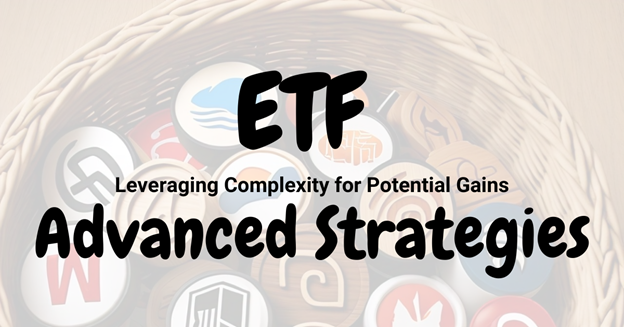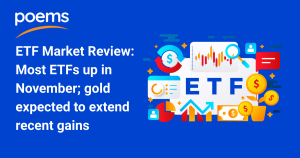Advanced ETF Strategies: Leveraging Complexity for Potential Gains July 22, 2024

Exchange-traded funds (ETFs) have revolutionised traditional investing by offering diversification and low costs. In our previous article. we talked about creating and managing your portfolio. However, beyond standard ETFs that track market indexes, there’s a world of advanced ETF products that can amplify returns albeit with risks. This article explores leveraged and inverse ETFs, their mechanics, and potential of a sophisticated investor’s portfolio.
Introduction to Advanced ETF Products
Leveraged and inverse ETFs are complex financial instruments designed to deliver multiples or the opposite of an index’s daily returns. Unlike traditional ETFs that simply track an index, these products use derivatives and debt to achieve their objectives.
Leveraged ETFs: Amplifying Market Movements
Leveraged ETFs aim to multiply the daily returns of an index. For example, a 2x leveraged S&P 500 ETF seeks to double the index’s daily movement, while a 3x fund aims to triple it. These funds use derivatives like futures contracts, equity swaps, and options to achieve leverage.
How they work: If the S&P 500 rises 1% in a day, a 2x leveraged ETF would aim for a 2% gain, while a 3x fund would target 3%. However, this works both ways – losses can be equally magnified.
Mark to Market and Leveraged ETFs:
“Mark to market” is crucial for leveraged ETFs’ daily operations. These funds rebalance their portfolios daily to maintain their promised leverage ratio by adjusting their assets to current market prices.
For example, a 3x leveraged ETF gaining 10% in a day would see its assets increase by 30%.
To maintain leverage, the fund adjusts its derivative positions (futures contracts, swaps, or options) based on the underlying index’s performance. If the index rises, the fund increases its derivative exposure; if it falls, the fund reduces exposure. This process allows efficient adjustment without direct borrowing or frequent trading of underlying securities.
While this daily rebalancing ensures the stated leverage ratio is maintained, it can lead to tracking errors over longer periods. With reference to the example below, even though both ETFs returns are proportionate to the leverage ratio, the final ETF values are unidentical.
| Day | Index Daily Return | ETF Value | 3X Leveraged Return | 3X Leveraged ETF Value |
| 0 | – | $100.00 | – | $100.00 |
| 1 | -10% | $90.00 | -30% | $70.00 |
| 2 | -10% | $81.00 | -30% | $49.00 |
| 3 | 10% | $89.10 | 30% | $63.70 |
| 4 | 10% | $98.01 | 30% | $82.81 |
| 5 | 2% | $100.00 | 6% | $87.81 |
Inverse ETFs: Profiting from Market Declines
Inverse ETFs move in the opposite direction of their benchmark index. When the market falls, they rise. Some inverse ETFs also incorporate leverage, aiming for -2x or -3x the daily index return.
Mechanics: These funds use similar derivative instruments as leveraged ETFs but take short positions to achieve the inverse effect.
Examples of Leveraged and Inverse ETFs
| ETF | Long (Leveraged) | Short (Inverse) |
| S&P500 | SPXL – Direxion Daily S&P 500 Bull 3X Shares | SPXS – Direxion Daily S&P 500 Bear 3X Shares |
| Nasdaq | TQQQ – ProShares UltraPro QQQ (3X) | SQQQ – ProShares UltraPro Short QQQ (3X) |
| Semiconductor | SOXL – Direxion Daily Semiconductor Bull 3X Shares | SOXS – Direxion Daily Semiconductor Bear 3X Shares |
| Bonds | TMF – Direxion Daily 20+ Year Treasury Bull 3X Shares | TMV – Direxion Daily 20+ Year Treasury Bear 3X Shares |
| Gold | UGL – ProShares Ultra Gold (2X) | GLL – ProShares UltraShort Gold (2X) |
Note:Leveraged and inverse ETFs are higher risk in nature and are not meant to hold for more than a few days. To trade leveraged and inverse ETFs, clients must ensure they clear CAR requirements
The Risks and Pitfalls of Complex ETFs
While these products can boost gains, they come with significant risks:
- Volatility decay: Daily rebalancing can erode returns over time, especially in volatile markets
- Tracking error: Over periods longer than a day, returns can differ significantly from the stated multiple of the index
- Compounding effects: In trending markets, returns can be greater than the stated multiple, while in volatile, sideways markets, returns can be lower.
- Mark-to-market impact: The daily rebalancing required by mark-to-market accounting can lead to increased trading costs and potential tax implications3.
These products are primarily designed for short-term trading, not long-term holding. They can be useful for:
However, they’re generally inappropriate for buy-and-hold investors or those who can’t actively monitor their positions.
Performance Evaluation and Portfolio Integration
When evaluating these ETFs, look beyond simple returns. Consider risk-adjusted metrics like Sharpe ratio and tracking error. Additionally, analyse liquidity and trading volumes too. The mark-to-market process can significantly impact an ETF’s performance, especially during periods of high market volatility 4.
Integrating these products into a portfolio requires careful consideration of overall asset allocation and risk management strategies. They should generally represent only a small portion of a well-diversified portfolio.
Regulatory Environment and Future Outlook
Regulators, including the SEC, have expressed concerns about the complexity and risks of these products. Investors should stay informed about potential regulatory changes that have impact on these ETFs, especially regarding their use of leverage and mark-to-market accounting practices.
Conclusion:
While leveraged and inverse ETFs offer possibilities for amplifying returns or hedging against market declines, they demand careful consideration.
The daily mark-to-market process, essential for maintaining the stated leverage ratios, adds another layer of complexity to these already sophisticated products.
When used strategically by knowledgeable investors who understand the risks, mechanics, and implications of daily rebalancing, these ETFs can enhance a portfolio.
However, their complexity and potential for significant losses mean they’re not suitable for everyone.
As with any investment, thorough research and a clear understanding of your financial goals and risk tolerance are essential before incorporating these advanced ETF strategies into your portfolio.
Your next step: save these useful tools under your investment arsenal.
Citations:
- https://www.investopedia.com/terms/m/mark-to-market-losses.asp
- https://equalsmoney.com/financial-glossary/mark-to-market
- https://www.investopedia.com/terms/m/marktomarket.asp
- https://corporatefinanceinstitute.com/resources/valuation/mark-to-market/
- https://www.investopedia.com/terms/l/leveraged-etf.asp
Disclaimer
These commentaries are intended for general circulation. It does not have regard to the specific investment objectives, financial situation and particular needs of any person who may receive this document. Accordingly, no warranty whatsoever is given and no liability whatsoever is accepted for any loss arising whether directly or indirectly as a result of any person acting based on this information. Opinions expressed in these commentaries are subject to change without notice. Investments are subject to investment risks including the possible loss of the principal amount invested. The value of the units and the income from them may fall as well as rise. Past performance figures as well as any projection or forecast used in these commentaries are not necessarily indicative of future or likely performance. Phillip Securities Pte Ltd (PSPL), its directors, connected persons or employees may from time to time have an interest in the financial instruments mentioned in these commentaries. Investors may wish to seek advice from a financial adviser before investing. In the event that investors choose not to seek advice from a financial adviser, they should consider whether the investment is suitable for them.
The information contained in these commentaries has been obtained from public sources which PSPL has no reason to believe are unreliable and any analysis, forecasts, projections, expectations and opinions (collectively the “Research”) contained in these commentaries are based on such information and are expressions of belief only. PSPL has not verified this information and no representation or warranty, express or implied, is made that such information or Research is accurate, complete or verified or should be relied upon as such. Any such information or Research contained in these commentaries are subject to change, and PSPL shall not have any responsibility to maintain the information or Research made available or to supply any corrections, updates or releases in connection therewith. In no event will PSPL be liable for any special, indirect, incidental or consequential damages which may be incurred from the use of the information or Research made available, even if it has been advised of the possibility of such damages. The companies and their employees mentioned in these commentaries cannot be held liable for any errors, inaccuracies and/or omissions howsoever caused. Any opinion or advice herein is made on a general basis and is subject to change without notice. The information provided in these commentaries may contain optimistic statements regarding future events or future financial performance of countries, markets or companies. You must make your own financial assessment of the relevance, accuracy and adequacy of the information provided in these commentaries.
Views and any strategies described in these commentaries may not be suitable for all investors. Opinions expressed herein may differ from the opinions expressed by other units of PSPL or its connected persons and associates. Any reference to or discussion of investment products or commodities in these commentaries is purely for illustrative purposes only and must not be construed as a recommendation, an offer or solicitation for the subscription, purchase or sale of the investment products or commodities mentioned.
About the author
MuMing Yong
ETF Specialist
Phillip Securities Pte Ltd
Mu Ming traded and invested for more than 8 years in various instruments including ETFs, Equities, Unit Trusts, Options, DLC, CFD, and ILP from the US, SG and HK market. He's a believer of personal finance, macroeconomics, and, technical analysis - so much so that he found himself analysing his social media engagement using trend lines and patterns.

 Buffer ETFs — What Are They and How Do They Work?
Buffer ETFs — What Are They and How Do They Work?  ETF Market Review: Most ETFs up in November; gold expected to extend recent gains
ETF Market Review: Most ETFs up in November; gold expected to extend recent gains  Should You Invest Your Supplementary Retirement Scheme (SRS) Savings?
Should You Invest Your Supplementary Retirement Scheme (SRS) Savings?  Factor-Based (Smart-Beta) ETFs: How They Work, Selection Criteria, and Practical Uses for Singapore Investors
Factor-Based (Smart-Beta) ETFs: How They Work, Selection Criteria, and Practical Uses for Singapore Investors 




